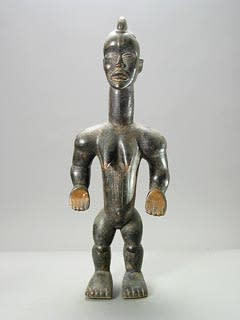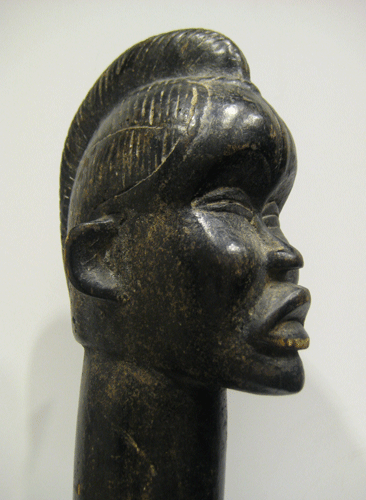Dan Wooden Sculpture of a Woman, 20th Century CE
Wood
7.5 x 32
PF.3389 (LSO)
Further images
This phenomenal work of art is a very rare and desirable “spouse” figure, made by the Dan people of Liberia and the Ivory Coast. It represents a standing woman in...
This phenomenal work of art is a very rare and desirable “spouse” figure, made by the Dan people of Liberia and the Ivory Coast. It represents a standing woman in full-square position, her palms facing forwards and her eyes closed. The build is muscular, and the carving is exceptionally dynamic. The feet are large, with nugatory toes, running into a well-shaped leg with the knees and even the kneecaps clearly defined. The buttocks are defined from the waist with an incised line, giving rise to a powerful body that widens to the shoulders. The torso is decorated with pointed breasts, a large umbilicus and an extensive incised and hatched linear design which runs from the loins to the neck. Another defined the groove between the buttocks and runs the whole length of the back. The arms are powerful and well-formed, with defined shoulders, biceps, forearms and paddle-shaped hands. The palms are painted with reddish-brown pigment. The head sits atop a tall, columnar neck (scarred on each side), with a square jaw, a pointed chin, a domed apex with a high, a crested coiffure (with herringbone design that reaches the nape of the neck), and prominent squared-off ears. The face is somewhat exaggerated, with recessed eyes under prominent brows, a snub nose and a very tall moue with thick lips. The piece has been repeatedly patinated with dark and light substances that still remain in the grooves and details.
The Dan are a farming tribe, settled in the semi-wooded areas of Liberia and the Ivory Coast. While beholden to agriculture, much of their mythology and social structure is based upon the forest and its fiercer creatures – the Leopard Society is the main organ of social control. For example, initiates spend up to four months alone in the forest before they are permitted to enter maturity. Dan society was originally a string of spatially-proximate but socially distinct communities, and while they are now – technically at least – centralised, their diversity has found expression in the range of masks and other artefacts that they manufacture.
It is face masks for which the Dan are best known; there was scarcely a social function that did not have its own mask prior to the 1960s. There are masks for fire-watching (= fire warden), social adjudicators, warriors, debt collectors, delinquents and warriors, and others for enlisting workers to clear paths, to catch runaway wives, to race unmasked athletes (“runner masks”) to snatch feast food to serve to children and even for spying. Masks were inherited through lineages, kept on altars and endowed with libations. However, figures are far rarer, and their usage is thus far less systematised. The only accounts of figures of this sort pertain to the habit of prominent chiefs who wish to honour their favourite wives. The figures were cared for, anointed and kept by the wife in question, and they were only seen in the event of dignitaries’ visitations. In the current case, one might conjecture that the painted hands reflect some fertility-linked issue, although this is inevitably somewhat uncertain.
This is a rare and impressive piece of African art.
The Dan are a farming tribe, settled in the semi-wooded areas of Liberia and the Ivory Coast. While beholden to agriculture, much of their mythology and social structure is based upon the forest and its fiercer creatures – the Leopard Society is the main organ of social control. For example, initiates spend up to four months alone in the forest before they are permitted to enter maturity. Dan society was originally a string of spatially-proximate but socially distinct communities, and while they are now – technically at least – centralised, their diversity has found expression in the range of masks and other artefacts that they manufacture.
It is face masks for which the Dan are best known; there was scarcely a social function that did not have its own mask prior to the 1960s. There are masks for fire-watching (= fire warden), social adjudicators, warriors, debt collectors, delinquents and warriors, and others for enlisting workers to clear paths, to catch runaway wives, to race unmasked athletes (“runner masks”) to snatch feast food to serve to children and even for spying. Masks were inherited through lineages, kept on altars and endowed with libations. However, figures are far rarer, and their usage is thus far less systematised. The only accounts of figures of this sort pertain to the habit of prominent chiefs who wish to honour their favourite wives. The figures were cared for, anointed and kept by the wife in question, and they were only seen in the event of dignitaries’ visitations. In the current case, one might conjecture that the painted hands reflect some fertility-linked issue, although this is inevitably somewhat uncertain.
This is a rare and impressive piece of African art.









